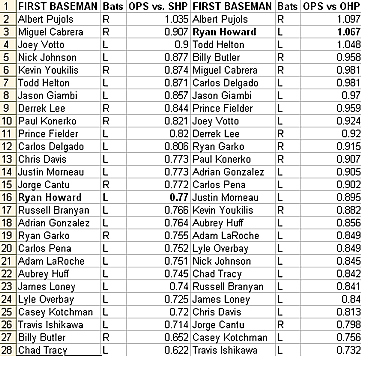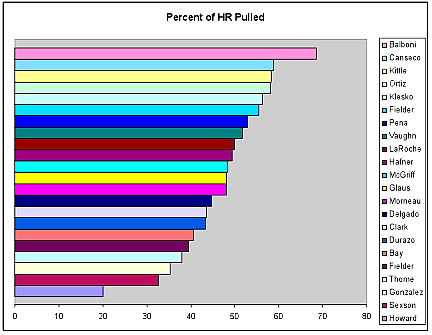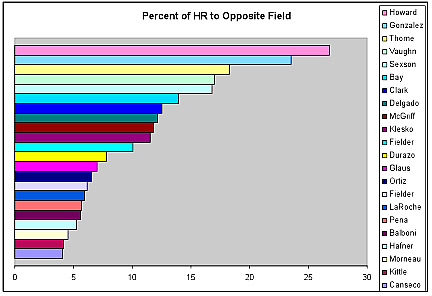BP Comment Quick Links

 | |
June 14, 2009 Prospectus Idol EntryRyan Howard, Swinging Hard in Case He Hits ItWhen I was seven years old, my dad called me into the living room to watch a Phillies' great in the twilight of his career-Mike Schmidt. He told me this was the best Phillie ever, and that I should watch him bat. He struck out. I turned to my dad with a look that must have asked, "Really?" My dad explained one of the first facts I ever learned about baseball-he said that guys who hit a lot of homeruns swing really hard, so they strike out a lot, too. That brings us to Ryan James Howard. Ryan Howard is one of the more fascinating players in baseball. He hits the ball the hardest, but also pretty much the least. On one hand, he has he led the majors in homeruns two of his three full seasons. Part of the reason is that Howard hits the ball hard, very hard. One study of Hit F/X data from April showed that Howard hit the ball 87.9 MPH on average. The next closest was Miguel Cabrera at 86.8 MPH, with the non-pitcher average of 75.1. And that's for a month in which Howard had a power-outage, hitting only 4 of his current 18 homeruns. On the other hand, Howard is tied with himself for second place for most single-season strikeouts with 199, and is on pace this year to slot fourth on that list-right behind himself with 196. Baseball Prospectus profiled him in detail last year. However, I've decided to update his profile-because I wanted to highlight a few surprising things about Howard that go against the conventional wisdom. MINOR LEAGUE CAREER The Phillies drafted Howard in the 5th round of the 2001 draft, and until 2004, he showed budding power and the tendency to strike out a lot. It wasn't until 2004 when Howard truly began to show the power we see today. He spent the 2004 season at three levels, hitting .297/.386/.647 in 420 PA in AA, .270/.362/.604 in 125 PA in AAA, and .282/.333/.564 in 42 PA in the MLB. That year, he hit a combined 48 HR, which tied him for the most HR in professional baseball. The Phillies already had Jim Thome at first, so they briefly tried an "experiment" in the minors putting Howard in the outfield. The experiment was as laughable as it was short. 2005 AND 2006: ROOKIE OF THE YEAR AND MVP CAMPAIGNS Howard was mashing in AAA in 2005 (.371/.467/.690), and after getting the call to Philadelphia to replace the injured Thome, Howard won the job quickly. Despite getting only 348 PA, Howard won the Rookie of the Year Award, hitting .288/.356/.567. However, his unintentional walk (UBB) rate was just 7.4%. His walk rate had been a concern going into 2005. Baseball Evolution keenly observed: The only skill he might want to improve on is the ability to take walks, and that's something that will come naturally as teams start to pitch around him. The Phillies dealt away Jim Thome before 2006, leaving first base open for Howard. PECOTA projected Howard to improve to .286/.375/.612, which was pretty shocking considering he was already 26. However, Howard won the MVP award by outperforming PECOTA's optimistic projection: he improved his UBB rate to 10.8%, slugged 58 HR, and hit .313/.425/.659. The biggest surprise in his numbers was his .313 batting average. The reason behind it was his .363 BABIP, which although lower than his minor league BABIP (.370), is extremely high for the major leagues. Yet, in late June 2006, teams started employing the shift against Howard, and his BABIP has never been the same. 2007 AND 2008: EARLY SLUMPS, STRONG FINISHES, AND THE BABIP REDUCTION PECOTA projected Howard to hit .299/.393/.616 in 2007, but Baseball Prospectus' 2007 Annual warned that this may be short-lived: Historically, players like Howard, big-bodied guys with limited defensive skills such as Mo Vaughn and Boog Powell, tended to have high but brief peak periods. Howard started off the year struggling, hitting just .221/.396/.390 by the end of April. He had a brief trip to the disabled list, which seemed to do the trick, and he finished at .268/.356/.567, with 47 HR in 529 AB. Howard improved his UBB rate to 11.8%, but he also increased his strikeout rate from 25.7% of PA to 30.7%. Facing more of the defensive shifts that started appearing in mid-2006, Howard's BABIP dropped to .336. Even more dramatically, his BABIP on groundballs fell from .250 to .187. Howard started slow again in 2008. By May 7, he was hitting .163/.286/.333. His K-rate was 34%, and his BABIP was .203. Howard was able to raise his BABIP to .285 by the end of the year, and finished the year at .251/.339/.543. This was a far cry from 2006, but he still hit 78 XBH. His K-rate fell back to 32.6%, as well, largely due to an increase in how often he swung (45.4% in 2007, 48.7% in 2008), as he only increased his contact rate from 64.7% to 66.5%. Digging deeper into Howard's performance shows us what we think we know about him is very different than what is actually true. In the next three sections, we will correct a few misconceptions about him, so that we can work towards projecting him. AVERAGE AGAINST LEFTIES, WILL EAT YOUR RIGHTHANDERS It has been recited many times that Howard's career OPS is a full .300 points lower against LHP. This has turned into what I called this off-season "The Ryan Howard Can't Hit Lefties Myth." Opposing teams believe this too, as the following table of Howard's percentage of PA against LHP versus the MLB average each year shows: YEAR Howard% MLB% 2005 18 28 2006 32 28 2007 38 27 2008 38 27 2009 40 27 However, take a look at these charts of career OPS against same-handed pitchers (SHP) on the left, and against opposite handed pitchers (OHP) on the right, among the 27 current non-switch hitting starting first baseman.
 Howard is actually not unusual in his performance against same-handed pitchers, as he's right around the middle of the pack. On the other hand, Howard gives Pujols a run for his money against opposite-handed pitching! And even though Howard is in the middle of the pack against same-handed pitching, he has led the NL in HR vs. LHP in two of the last three seasons. The lesson we should draw from this is not that Howard is freakishly bad against same-handed pitching-he's actually about average among first basemen; rather, the lesson is that Howard, like Pujols, is freakishly good against opposite-handed pitching. THERE IS CLUTCH? I documented something unusual recently-there is such a thing as clutch-okay, at least that's what I called the article to get attention. What I meant is the following: Due to the location of first base (the right side of the infield), teams employ large shifts for left-handed power hitters when it is possible, frequently placing three infielders on the right side of the diamond. However, when there are runners on base, it is more difficult to position infielders in such a way that minimizes the hitter's chance of hitting safely if he hits the ball in play. The result is that for a given batting average, a left-handed power hitter is actually more likely to get those hits when runners are on base. These are naturally higher leverage situations in general. Hence, a given batting line for a left-handed power hitter is more valuable than the equivalent batting line for right-handed power hitters. While Howard was not one of the players in my study, he fits quite well. The MLB cumulatively had a BABIP .006 better with men on than when bases were empty in 2008. Howard is different. He has fared far better with runners on base ever since teams started employing the shift against him. Look at the change after 2006: YEAR BABIP (bases empty) BABIP (men on) 2005 .373 .333 2006 .387 .318 2007 .309 .344 2008 .218 .347 2009 .289 .279 Obviously 2008 is a bit extreme and 2009 is not showing this trend, but 2007 is very much in line with the kinds of numbers I saw for hitters like Ortiz, Bonds, and Giambi in my earlier study. Thanks to the ways teams use the shift (and without any voodoo or secret sauce from Joe Morgan), Ryan Howard is clutch. OPPOSITE FIELD POWER VS. COMPARABLES In projecting Ryan Howard's future, there is a lot to be concerned about. Baseball Prospectus warned in 2008: Howard's PECOTA comparables suggest the system doesn't expect him to have a long battery life, a reflection of his late start and old-player skills. Still, Howard is a better hitter than any of those guys. The reason PECOTA is successful developing comparables from both statistics and body type is because players who are shaped similarly are likely using similar muscles and reflexes to succeed, and determining how comparably constructed players aged is useful in projection. PECOTA sees Howard around .270/.370/.550 through 2011, and then losing power from 2012-2015 at .260/.360/.520. Beyond just being better than his comparables as BP2008 mentions, there is one area where Howard is extraordinarily different than his comparables. Howard does not hit his homeruns in the same location as his comparables. As early as 2005, Baseball America wrote: When you have power like him, you don't have to pull it. It's not like any park can hold him. As pitchers try to throw outside, Howard frequently won't bother pulling the ball. Consider the following plot of the percent of homeruns that were pulled among Howard's PECOTA comparables (who have homerun location data), as well as other comparables listed on baseball-reference.com. Howard has pulled only 20.5% of his homeruns in his career; the rest of his comparables averaged around 48.6%.
 On the other hand, look at the percent of homeruns hit to the opposite field. Howard tops this group by far as well-hitting 26.7% of his homeruns the other way, versus his comparables' average of 10%.
 In determining which of his comparables Howard is most likely to follow as he ages, I decided to see whether the guys who hit more opposite field homeruns aged differently than those who pulled the ball. It appears that guys like Thome, McGriff, and Clark aged a little better and hit fewer homeruns to the opposite field. Other players, like Cecil Fielder and Steve Balboni pulled more homeruns and aged less gracefully. Therefore, Howard may age better than PECOTA expects. 2009 AND THE DEFENSIVE RESURGENCE Howard has played very poor defense throughout his career, but has struggled most with his throwing. He made 45 errors in 2006-08 (19 last year), and 14 of those 45 were throwing errors. Howard worked hard on his defense this offseason. He increased his mobility in the field by checking into spring training twenty pounds lighter, and improved his throwing as well. His hard work has paid off, as he has made only one error this season. Further, despite averaging only .618 assists per game in his career, Howard has .732 thus far this year. LOOKING FORWARD Due to permanent defensive adjustments, Howard's BABIP reduction is real. That said, I think his power is unlikely to diminish any time soon, as he continues to hit as many long flyballs as ever. Howard has tried to curb his strikeouts by swinging more often, so his UBB rate has fallen to 9.4%. Putting it all together, PECOTA is probably a little high on his AVG and OBP, and probably low on his SLG-I see him as a .260/.355/.570 hitter. I also suspect he may last a little bit longer than PECOTA thinks, but the key to this will be Howard's weight. The hitters among his comparables that were larger tended to age more quickly. If he can keep the weight off, he should manage to lead the league in homeruns a few more times over the next several years.
Matt Swartz is an author of Baseball Prospectus.
|
This seemed a lot longer than 2000 words. Maybe it's the chart or the sheer density of Matt's work, or maybe it's just me. He's readable, even breezy, but then pounds the data in. My only real quibble with this is that he's all over the place with a chart for this, a short section on clutch, and a very short summary that I'm not sure does the best job summarizing because there was so much here. Quibbles aside, that stands up very well to the profiles we've published here.